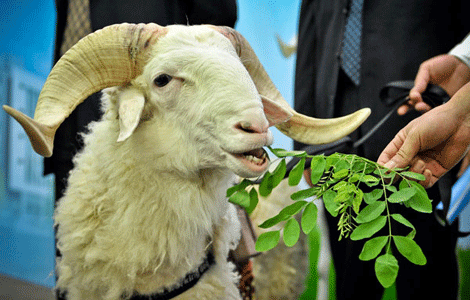
NANCHANG - Once an aquafarm close to bankruptcy, Haiwan Farm has been revitalized a decade later thanks to its successful transition to an agritourism base for urban residents.
Located in the outskirts of Nanchang, capital of east China's Jiangxi province, the farm has become a favorite weekend destination for many city dwellers.
Located just an hour from downtown Nanchang, the farm is a garden of green with various vegetables and fruits on display. It also has a massive fishery.
"Visitors can pick up and buy pollution-free cucumbers and strawberries in the fields, as well as dine here with fresh fish from the pond," said Hu Haishui, who took over the farm in 2002.
The farm received about 20,000 visitors in 2012 and reaped 47.5 million (7.6 million U.S. dollars) yuan in revenues.
Hu's farm also employs about 200 people, more than 85 percent of whom are local farmers.
Qi Aixiang, a farmer in her 60s from the village of Xiebu, has a part-time job at the farm with a daily income of 50 yuan. Her husband is a full-time farm maintenance worker with a monthly income of 2,200 yuan.
Their yearly income is nearly triple the average yearly income of farmers in Nanchang, which stood at 9,587 yuan in 2012.
"As elderly people, we are quite satisfied with what we earn here," said Qi.
The farm has also taken advantage of its planting and fishery techniques to provide seedlings and technical support for local farmers. It also purchases farm produce from them.
"More than 200 households have maintained long-term cooperation with us. Every household can make more than 8,300 yuan in profits each year by working with us," Hu said.
Demand for agritourism has boomed along with the per capita income of Chinese. The country's long history of farming, as well as the natural beauty of some of its farms, are attractive to many, said Zhu Baocheng, a senior official from the Agriculture Ministry.
A survey of 135,000 recreational farming proprietors showed that 92.4 percent of their employees are farmers.
There were about 1.7 million recreational farming and agritourism enterprises as of the end of 2012, employing 6.9 percent of the total rural labor force, said Zhang Tianzuo, head of the township enterprise department under the Ministry of Agriculture, at a forum held in Nanchang last week.
Those enterprises received 800 million tourists in 2012 and reaped more than 240 billion yuan in revenues, Zhang said.
The development of recreational farming has expanded the functions of traditional agriculture and improved the sector's efficiency. It has also become a driver of domestic consumption and helped reduce the urban-rural gap, he said.
However, most of the enterprises focus on providing rural-style food and accommodation, which will not be enough to maintain further development, he said.
He calls for recreational farm operators to create a differentiated development strategy based on their own resources.







